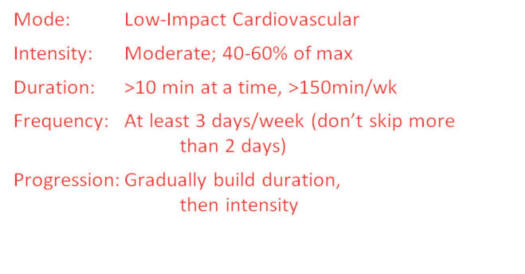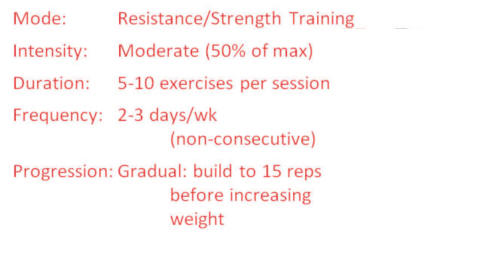|
Exercise Prescription It is highly beneficial to provide a detailed, written physical activity plan (called an “exercise prescription) that is individualized for each patient. An example of an aerobic exercise plan is outlined here. In terms of intensity, here’s a helpful tip: during physical activity, a person should be able to sing or carry on a conversation with a partner. If a person is too short of breath to talk during the activity, he or she may be overdoing it and should slow down or rest briefly.
Source: American College of Sports Medicine / American Diabetes Association Joint Position Statement: Exercise and Type-2 Diabetes, Medicine & Science in Sports & Exercise 2010, 2282-2303. Strength training is also highly beneficial for most people with type-2 diabetes. An example of a strength-training plan is outlined here. It is important to use proper lifting technique to avoid injury. One should never hold their breath while lifting as this can cause a potentially dangerous increase in blood pressure. Instruct patients to exhale (i.e. “blow air out”) when contracting a muscle, and inhale when relaxing a muscle.
Source: American College of Sports Medicine / American Diabetes Association Joint Position Statement: Exercise and Type-2 Diabetes, Medicine & Science in Sports & Exercise 2010, 2282-2303.
To prevent injuries and complications, people with diabetes need to take precautions to ensure safe physical activity. To ensure safe physical activity, remind people to: • Test blood glucose before and after physical activity. Exercising while blood glucose is outside the target range (too high or too low) increases the risk of acute complications. •Always warm up and cool down. Before physical activity, people should warm up with easy, low-intensity movements. Once muscles are warm, gentle stretching is recommended. When ready to cool down, the activity should not be stopped abruptly. Rather, advise people to slow down the activity, then stretch their muscles again while they are still warm. • Reduce the risk of injury with appropriate clothing and equipment, including well-fitting athletic shoes and absorbent socks. People with diabetes should examine their feet daily and after physical activity to check for redness, blisters, cuts, and sores. Advise them to check inside their shoes before wearing and remove any foreign objects, such as pebbles or debris that could cause injury. • Prevent dehydration. People should begin physical activity well hydrated, and replace body fluids during activity. Water is the best fluid replacement. Adequate hydration helps to prevent muscle cramping and maintain body temperature and blood volume. • Wear or carry diabetes identification, such as a Medic Alert bracelet or an information card that can assist with treatment should an emergency occur. Also, advise people to bring money for a phone call or consider carrying a cell phone during physical activity.
|





.10.jpg)